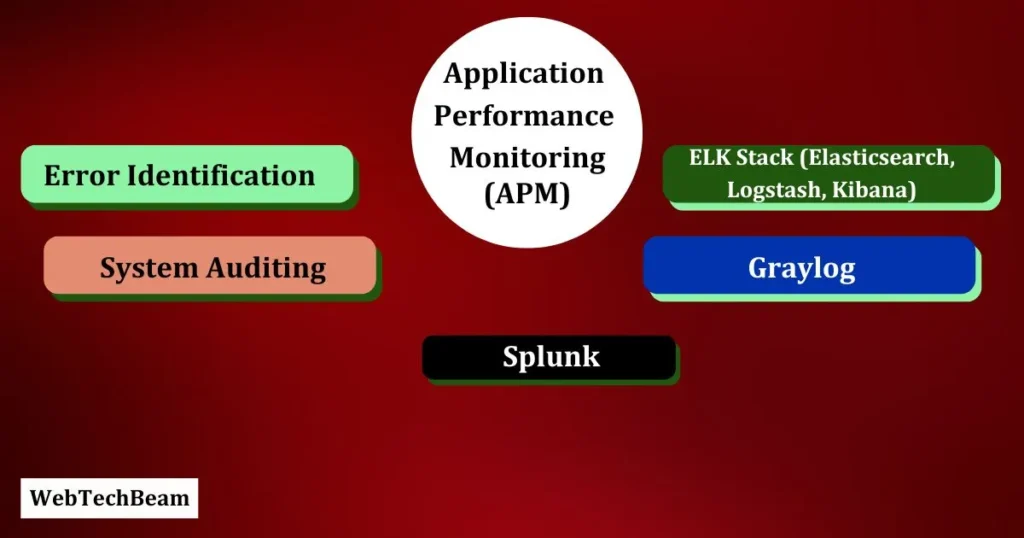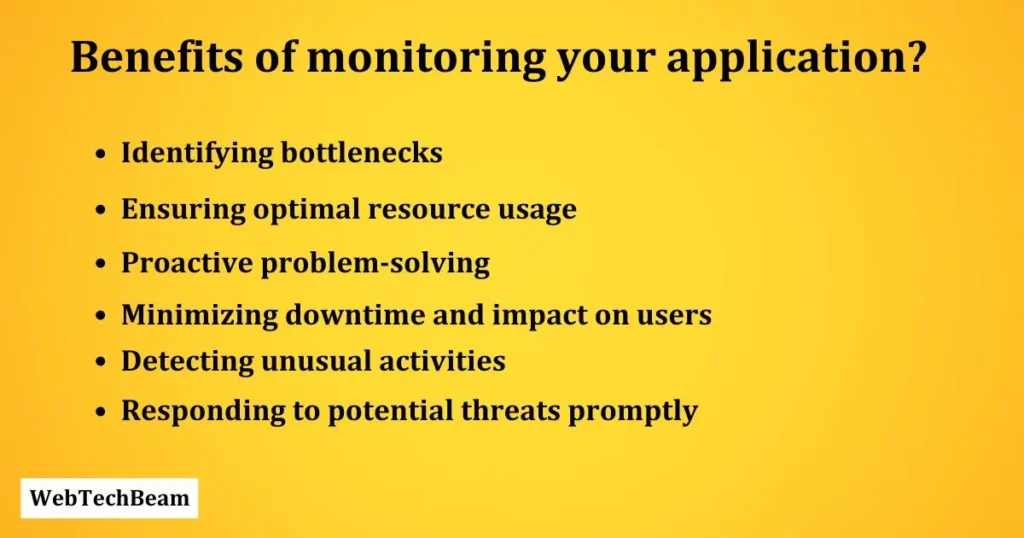Why Monitoring You Application is Important?

Application monitoring refers to the continuous checking and tracking of an application’s performance and functionality. By keeping an eye on how the application is working, developers can quickly spot any issues or problems that may arise. This is crucial because it helps ensure that the application remains reliable and performs well, providing a good user experience.
Maintaining robust applications, or strong and reliable software, means fewer disruptions for users and more efficient problem-solving for developers. This helps in keeping the application running smoothly and efficiently over time.
In this post we will discuss in detail about Why Monitoring You Application is Important?
What Is Application Monitoring?
Application monitoring is the practice of continuously observing and analyzing the performance, availability, and overall health of an application. It involves collecting various metrics and logs, such as response times, error rates, and resource usage, to gain insights into how the application is functioning.
These data points help developers and IT teams to identify and diagnose issues, optimize performance, and ensure the application meets its service level agreements (SLAs).
Effective application monitoring allows for proactive maintenance, minimizing downtime, and improving the end-user experience by quickly addressing any anomalies or failures that may occur.
Types of Monitoring Tools
Performance Monitoring Tools

Examples and features:
- New Relic: This tool offers real-time performance monitoring and detailed insights into application performance, including slow transaction traces and detailed error analysis.
- AppDynamics: Known for its comprehensive monitoring capabilities, AppDynamics provides detailed metrics on application health, end-user experience, and performance bottlenecks, making it easier to identify and resolve issues.
- Datadog: Datadog is a cloud-based monitoring tool that provides a unified view of metrics, logs, and traces from various applications, offering powerful visualizations and alerting capabilities.
Performance monitoring tools help ensure that your application runs smoothly and efficiently by continuously tracking various performance metrics. They can help identify bottlenecks, optimize resource usage, and provide detailed insights into application performance.
Logging and Analytics Tools
Importance of logs:
- Error Identification: Logs are essential for identifying errors and understanding the circumstances under which they occurred.
- System Auditing: Logs provide a detailed record of all activities within the application, which is crucial for auditing purposes.
- Performance Monitoring: Logs can help monitor the performance of different application components and trace the source of issues.
Tools for comprehensive analytics:
- Splunk: Splunk is an analytics tool that turns machine data into operational insights. It offers real-time search, analysis, and visualization of logs, helping to monitor and troubleshoot performance issues.
- ELK Stack (Elasticsearch, Logstash, Kibana): This open-source toolset helps in collecting, analyzing, and visualizing log data. Elasticsearch provides powerful search capabilities, Logstash processes and transforms log data, and Kibana offers rich visualizations.
- Graylog: Graylog is another open-source tool that focuses on log management and analysis. It allows for real-time log analysis and provides a highly configurable dashboard for visualizing log data.
Logging and analytics tools provide valuable insights into an application’s performance and user interactions by capturing and analyzing log data.
Security Monitoring Tools
Ensuring application safety:
Security monitoring tools play a critical role in safeguarding applications by detecting and preventing potential security threats.
Popular security monitoring tools:
- Snyk: Snyk focuses on identifying and fixing vulnerabilities in an application’s dependencies, container images, and code. It integrates seamlessly with development workflows to ensure security from the early stages of development.
- Snort: Snort is an open-source network intrusion detection system (NIDS) that monitors network traffic for suspicious activity and alerts users when such activities are detected.
- OSSEC: OSSEC stands for Open Source Security Event Correlator. It is a comprehensive open-source tool for monitoring and analyzing system logs, detecting intrusions, and ensuring compliance.
By using these security monitoring tools, developers can proactively protect applications from potential threats, ensuring that sensitive data remains secure and maintaining user trust.
These tools collectively form a comprehensive monitoring strategy, helping developers maintain optimal performance, ensure reliability, and secure their applications against potential threats.
What are the benefits of monitoring your application?

Performance Optimization
- Identifying bottlenecks:
Application monitoring helps to locate any points within the application where performance slows down. These points, known as bottlenecks, can significantly affect the overall performance if not addressed. By identifying bottlenecks, developers can take targeted actions to resolve these issues, ensuring that the application runs smoothly.
- Ensuring optimal resource usage:
Monitoring apps allows developers to track how resources such as memory, CPU, and bandwidth are being used. This helps in making sure that these resources are utilized efficiently. By optimizing resource usage, it is easier to avoid waste and ensure that the application performs well even under heavy load.
Early Detection of Issues
- Proactive problem-solving:
With continuous monitoring, potential issues can be detected before they become serious problems. This proactive approach allows developers to fix issues before they impact users, ensuring a more reliable application. Early detection helps in maintaining the application’s health and stability over time.
- Minimizing downtime and impact on users:
The immediate identification of issues means that developers can quickly address them, minimizing any downtime. Less downtime means a better experience for users, as they are less likely to encounter disruptions while using the application. This helps in maintaining a good reputation for the application and the company behind it.
Improved Security
- Detecting unusual activities:
Monitoring can also track unusual activities within the application that might indicate security threats, such as unauthorized access attempts or unexpected data transfers. By quickly spotting these activities, it becomes easier to take immediate action and prevent any potential security breaches.
- Responding to potential threats promptly:
Once a potential threat is detected, monitoring tools can alert the developers immediately. This quick response is crucial in mitigating the risk of security threats, ensuring that the application remains secure. Fast response times help protect both the application and its users from potential harm.
FAQs
1. What is application monitoring?
Application monitoring refers to the process of continuously observing and analyzing various metrics and logs from software applications to ensure optimal performance, reliability, and security. It helps developers identify and address issues proactively before they affect users.
2. Why is monitoring important for applications?
Monitoring is essential as it helps identify performance bottlenecks, optimize resource usage, detect security threats, and minimize downtime. It ensures that applications run smoothly, securely, and efficiently, thereby enhancing user satisfaction and maintaining the application’s reputation.
3. What tools can be used for application monitoring?
Several tools are available for application monitoring, including Splunk, ELK Stack, Graylog, Snyk, Snort, and OSSEC. These tools offer different functionalities such as log analysis, performance monitoring, and security threat detection, providing a comprehensive monitoring solution.
4. How does application monitoring enhance security?
Application monitoring enhances security by detecting unusual activities that might indicate potential threats, such as unauthorized access attempts or unexpected data transfers. It also enables quick response times to these threats, thereby mitigating risks and protecting both the application and its users.
5. Can monitoring help in resource optimization?
Yes, monitoring can help in resource optimization by tracking the usage of resources like memory, CPU, and bandwidth. By analyzing these metrics, developers can ensure efficient resource utilization, avoid wastage, and maintain application performance even under heavy load.
6. What are the benefits of early detection of issues through monitoring?
Early detection of issues allows developers to fix problems before they escalate and affect users. This proactive approach minimizes downtime, maintains application stability, and ensures a seamless user experience. It also helps maintain the application’s health over time.
7. What is the Purpose of Application Monitoring?
Application monitoring serves to track the performance and functionality of software applications. It helps identify issues before they impact users or business operations significantly. By collecting performance data, teams can assess application health in real time.
8. Why is Monitoring Important?
Monitoring is important because it ensures applications run easily and professionally. It allows teams to detect and resolve problems quickly, minimizing downtime. Through effective monitoring, organizations can improve user experience by maintaining system reliability and performance.
9. Why Do We Need Application Performance Monitoring?
Application performance monitoring helps evaluate application responsiveness and overall user satisfaction. It provides insights into resource usage, leading to better performance optimization plans. By understanding performance bottlenecks, teams can improve application speed and reliability.
10. What is the Main Purpose of Monitoring?
The main purpose of monitoring is to maintain software application health through practical management. It enables teams to meet user expectations and service level agreements confidently. Regular monitoring identifies performance trends, allowing for informed decision-making.
11. How to Do Application Monitoring?
To do application monitoring:
- Deploy monitoring tools that track key performance metrics effectively.
- Set up alerts to notify teams of potential issues before they escalate.
- Regularly review collected data to detect patterns and improve overall application performance.
12. Why is Process Monitoring Important?
Process monitoring is vital as it ensures that each application component operates as intended. It helps pinpoint specific areas that may cause delays or failures. By monitoring processes, teams can enhance workflow efficiency and boost application performance overall.
Conclusion
Why Monitoring You Application is Important? Because its help for maintaining the health and performance of software applications. By continuously observing and analyzing application metrics, logs, and user interactions, developers can identify performance bottlenecks, resource inefficiencies, and potential security threats. Effective monitoring tools, such as Splunk, ELK Stack, Graylog, Snyk, Snort, and OSSEC, empower developers to proactively address issues, ensuring that applications run smoothly and securely.
Proactive monitoring fosters a more reliable and responsive application environment. By catching issues early, developers can resolve problems before they escalate and impact users. This approach minimizes downtime, ensures optimal resource utilization, and enhances application security.
Ultimately, investing in comprehensive monitoring strategies results in greater user satisfaction, as applications perform consistently and securely, reinforcing the trust and reputation of the organization behind them.





